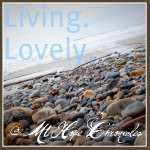
And none will hear the postman’s knock
Without a quickening of the heart.
For who can bear to feel himself forgotten?
~W.H. Auden
Did anyone
Send a Handwritten Letter
this week?
With the advent of emails and texting, do you still write letters often?Did you ever enjoy writing letters in the past?Have you ever had a penpal?Do you enjoy receiving a handwritten letter?
Does a handwritten letter feel differently than an email or phone call?
What is the best letter you have ever received?
Speaking of letter writing…
I have a give-away coming Friday!
Don’t miss it!
(Scroll down for next week’s Living. Lovely. challenge.)
~~~~~~~~~~~~~~~~~~~~~~~~~~~~~~~~~~~~~~~~~~~~~~~~
I loved getting mail when I was younger.I’d race to the mailbox each day.I loved catalogs. I loved magazines.
I really loved letters.
I had several penpals over the years.A boy in Korea.A girl I met at summer camp.An unlikely and unexpected friendship formed when I was in second grade with a much older student.
She wanted to be a teacher and made up these lovely worksheets for me to do.
I can still picture them in my head.Call me crazy. I loved worksheets. I loved the star chart she made for me.I was devestated when she moved away.
And then the packet came in the mail. More worksheets lovingly handwritten.
After I outgrew the worksheets, we continued to write on occasion.I have seen her only once since second grade…10 years later I attended her wedding.Is it any surprise that she became a teacher and I became a homeschooling mom?
To this day, almost 30 years later, we continue to exchange Christmas cards.
I saved most of the notes passed in class during highschool.
Hundreds, it seems, from my best friend, Char.
Russ and I had a long-distance relationship for a few months.I can’t tell you what it meant to get letters from him.This was before email…but he did send send me a fax at work on occasion.
I saved all of those, too. Grin.
Now I’m in the mood to go through my box of old letters….
I rarely mail hand-written letters anymore.My boys do have penpals, though.
They exchange letters and pictures with the boys from Thoughts of Home.
We set to work this week on the latest batch of words and drawings. 
I also sent a get-well card to a friend,
and notes with updated pictures of the boys to grandparents.
(Yes, Grandma and Grandpa, yours is in the mail. Grin.)
~~~~~~~~~~~~~~~~~~~~~~~~~~~~~~~~~~~~~~~~~~~~~~~~~
Our next Living. Lovely. challenge:
Read Something Lovely
Something soul-affirming. Something beautiful.
Something your mind can ponder after you’ve set the words down.
Poetry. Literature. Quotes. Lyrics. Memoir. Letters. Devotional.
Spend time interacting with the ideas and images that linger in your mind.
Think on things that are lovely.
Why should we think upon things that are lovely?
Because thinking determines life.
It is a common habit to blame life upon the environment.
Environment modifies life but does not govern life.
The soul is stronger than its surroundings.
~William James
It is one of my favorite books I’ve read this year, truly on my all-time favorites list.
I’ll share more next Thursday, but for now I leave you with this quote:
pp. 30-31The writer does want to be published; the painter urgently hopes that someone will see the finished canvas (van Gogh was denied the satisfaction of having his work bought and appreciated during his lifeitme; no wonder the pain was more than he could bear); the composer needs his music to be heard. Art is communication, and if there is no communication it is as though the work has been stillborn.
The reader, viewer, listener, usually grossly underestimates his importance. If a reader cannot create a book along with the writer, the book will never come to life. Creative involvement: that’s the basic difference between reading a book and watching TV. In watching TV we are passive; sponges; we do nothing. In reading we must become creators. Once the child has learned to read along and can pick up a book without illustrations, he must become a creator, imagining the setting of the story, visualizing the characters, seeing facial expressions, hearing the inflection of voices. The author and the reader “know” each other; they meet on the bridge of words.